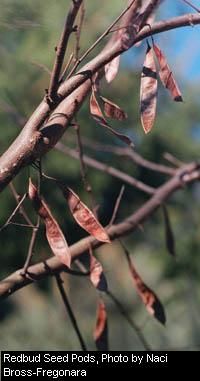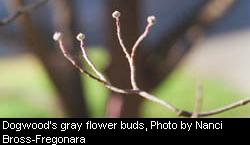Mountain State
Flora: Identifying Winter Plants
By John Beckman
Identify plants in winter? It sounds a little crazy, but it is possible
to identify plants by using characteristics that persist throughout the
winter. If you are interested in winter botany, it will be worth the money
to invest in a field guide that specializes in winter plant identification.
 Two recommended books are Weeds in Winter
by Lauren Brown, and Woody Plants in Winter by Core and Ammons. These
books use specific patterns on the twigs, buds and bark to differentiate
species. Persistent fruits are also a good way to identify plants in winter.
For example, redbud trees have bean-like seed pods that often remain after
the leaves have fallen. Flowering dogwood trees produce clusters of familiar
bright red berries. Maple trees retain seeds that spin like helicopter
blades in the wind, and the fruits of burdock weeds are the bean-sized
burrs that cling tenaciously to sweaters and socks. Two recommended books are Weeds in Winter
by Lauren Brown, and Woody Plants in Winter by Core and Ammons. These
books use specific patterns on the twigs, buds and bark to differentiate
species. Persistent fruits are also a good way to identify plants in winter.
For example, redbud trees have bean-like seed pods that often remain after
the leaves have fallen. Flowering dogwood trees produce clusters of familiar
bright red berries. Maple trees retain seeds that spin like helicopter
blades in the wind, and the fruits of burdock weeds are the bean-sized
burrs that cling tenaciously to sweaters and socks.
Whenever I try to identify trees in winter, I “cheat” by looking
at the leaves on the ground surrounding the base of the tree. Chances
are some of the leaves from the tree above will remain on the forest floor
for quite some time. Be careful when using this technique, however. Fall
breezes can spread leaves from different trees all over the forest.
Habitat location is another useful clue in
identifying plants in any season. Many species strongly prefer high, dry
ridges, and other plants will only be found near water. Botany field guides
will usually note a plant’s preferred soil moisture and elevation
--more clues to help you learn winter plants.
 When venturing out on a winter botany field trip, bring along your field
guides and some plastic bags in which to carry collections of twigs, nuts
and dried leaves. A magnifying glass is extremely useful for examining
tiny hairs and miniscule scars on twigs. When venturing out on a winter botany field trip, bring along your field
guides and some plastic bags in which to carry collections of twigs, nuts
and dried leaves. A magnifying glass is extremely useful for examining
tiny hairs and miniscule scars on twigs.
Keep a notebook handy for writing down where you saw the plant and in
what sort of habitat you found it. Chances are, the plants you collect
in winter will sprout in the same place in the spring. Returning to collection
sites during the summer will help you check if your winter identification
was correct.
John Beckman is a former DNR wildlife biologist now working in Virginia
|

